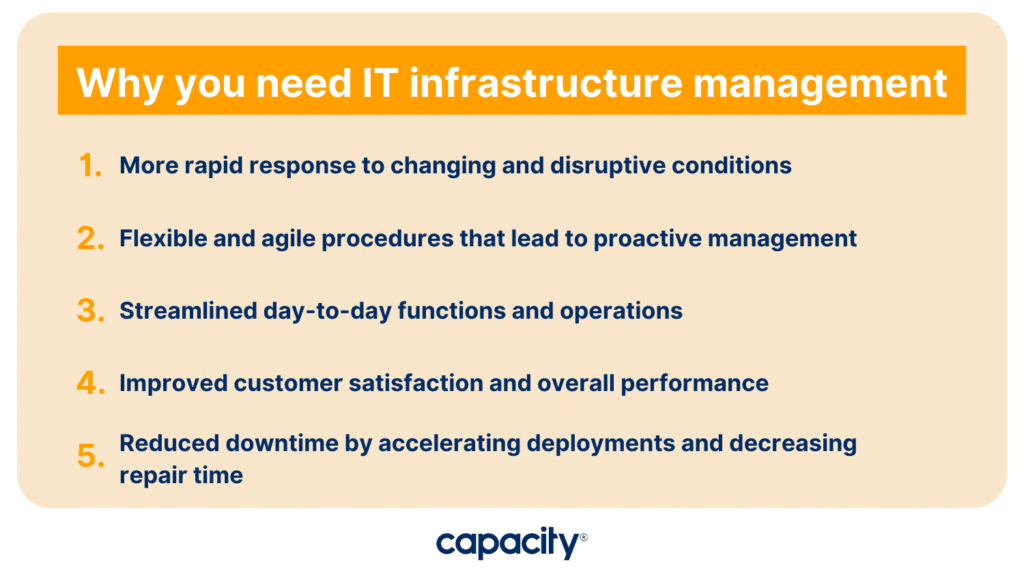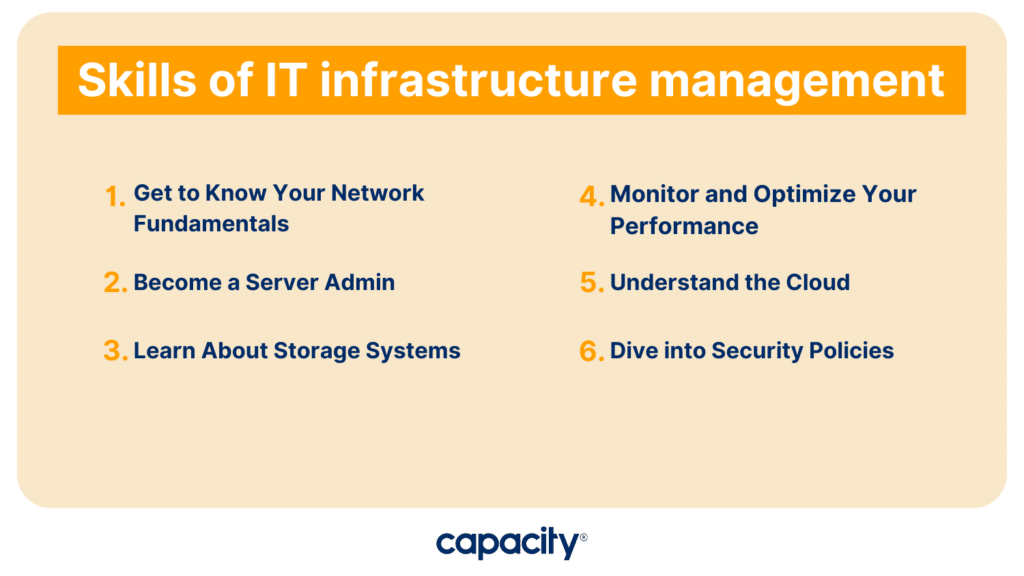Mastering IT infrastructure management is a necessity, not an option. As organizations continue to lean heavily on technology to drive operations, it’s critical to optimize the tools, systems, and processes that keep the gears turning. This guide will explore the intricacies of IT infrastructure management, highlighting the benefits it offers to modern organizations.
Then, we’ll also explain and expand on the key skills that every IT member needs to excel in this complex yet vital field. And since the future of IT is automation, we’ll shed light on how tools like Capacity can automate and streamline IT management processes.
What is IT infrastructure management?

IT Infrastructure Management refers to the process of overseeing and maintaining an everything that has to do with IT, which includes hardware, software, networks, servers, storage, and other components. So, it involves designing, implementing, monitoring, and optimizing IT systems to ensure they align with business objectives, support operations, and enable growth.
Additionally, IT infrastructure management encompasses various areas, including network management, server administration, storage systems, security, cloud computing, and performance optimization. Therefore, it involves tasks such as installing and configuring hardware and software, monitoring network and system performance, managing security protocols, ensuring data backup and recovery, and troubleshooting issues.
Overall, the goal of IT infrastructure management is to ensure that the organization’s IT resources are effectively used, reliable, secure, and aligned with business needs. The process then involves strategic planning, proactive maintenance, and continuous improvement to optimize IT operations, minimize downtime, and maximize efficiency and productivity.
Why you need IT infrastructure management
One report notes that 83% of organizations have proactive IT operations implemented. And, ultimately, robust IT infrastructure management practices offer several significant benefits that are vital for the success of modern organizations. So, let’s explore some of these key advantages:

1. More rapid response to changing and disruptive conditions
When you’re effectively managing IT infrastructure, your business can swiftly adapt to changing market conditions, technological advancements, and disruptive events. This agility enables organizations to seize new opportunities, respond to customer demands promptly, and stay ahead of competitors.
2. Flexible and agile procedures that lead to proactive management
Efficient IT infrastructure management fosters flexible and agile procedures, allowing organizations to proactively address potential issues before they escalate. Proactive management helps prevent downtime, identify vulnerabilities, and implement necessary changes to optimize operations and enhance overall performance.
3. Streamlined day-to-day functions and operations
An organized and well-managed IT infrastructure streamlines day-to-day functions and operations, reducing manual effort, minimizing errors, and enhancing productivity. This enables IT teams to focus on strategic initiatives, innovation, and supporting the overall business strategy.
4. Improved customer satisfaction and overall performance
A well-maintained IT infrastructure directly impacts customer satisfaction and overall business performance. Reliable systems, seamless user experiences, and minimal disruptions contribute to positive customer experiences, enhanced reputation, and increased customer loyalty.
5. Reduced downtime by accelerating deployments and decreasing repair time
Efficient IT infrastructure management minimizes downtime by optimizing deployment processes and reducing repair time. In a recent survey of IT teams, 76% of respondents stated that the complexity of the IT landscape is the biggest barrier to productivity among IT operations teams. Automated workflows, standardized configurations, and proactive maintenance help ensure smooth operations and minimize service disruptions, saving valuable time and resources.
Skills of IT infrastructure management
To excel in IT infrastructure management, certain key skills are essential. Here are the foundational skills that every IT professional should focus on:

Get to Know Your Network Fundamentals:
Start by building a strong foundation in networking. Understand IP addressing, subnetting, routing protocols, and network troubleshooting techniques. This knowledge forms the backbone of IT infrastructure management.
Become a Server Admin:
Gain proficiency in server installation, configuration, and management. Familiarize yourself with server hardware, operating systems, virtualization technologies, and backup strategies. This knowledge is crucial for maintaining a stable and secure server infrastructure.
Learn About Storage Systems:
Explore different storage technologies, including direct-attached storage (DAS), network-attached storage (NAS), and storage area networks (SAN). Understand concepts like RAID (redundant array of independent disks), data redundancy, storage provisioning, and disaster recovery strategies.
Dive into Security Policies:
Develop a solid understanding of cybersecurity principles. Learn about authentication mechanisms, firewalls, intrusion detection systems, encryption, access control models, and security best practices. Protecting data and systems from threats is paramount in IT infrastructure management.
Understand the Cloud:
Acquire knowledge about cloud computing, including cloud service models (IaaS, PaaS, SaaS), virtualization, scalability, and elasticity. Familiarize yourself with different cloud providers, deployment models, and cloud management tools.
Monitor and Optimize Your Performance:
Learn about monitoring tools and techniques to ensure optimal performance of IT infrastructure. Understand concepts like load balancing, caching, performance tuning, and resource optimization. Continuously monitor infrastructure health, identify bottlenecks, and proactively optimize resource use.
How to automate your IT infrastructure management processes
Automation plays a crucial role in modern IT infrastructure management. It streamlines operations, improves efficiency, and enables IT teams to focus on strategic initiatives. One tool that can greatly assist in automating IT management processes is Capacity.
Capacity is an AI-powered automation platform that uses machine learning and natural language processing to automate IT tasks, resolve user queries, and provide valuable insights. With Capacity, you can automate routine tasks, streamline workflows, and gain actionable intelligence to make informed decisions.
To automate your IT infrastructure management processes effectively, consider the following steps:
- Identify Repetitive Tasks: Identify tasks that are repetitive, time-consuming, and prone to human error. These are the ideal candidates for automation.
- Evaluate Tool Integration: Ensure the automation solution integrates seamlessly with your existing IT infrastructure, including network devices, servers, storage systems, and monitoring tools.
- Define Workflows and Triggers: Define workflows and triggers to automate processes. For example, you can automate server provisioning, user onboarding, backup and recovery, security patching, and performance monitoring.
- Implement Intelligent Chatbots: Integrate intelligent chatbots into your IT infrastructure to automate user support, handle common queries, and provide self-service options. This frees up IT staff for more complex tasks.
- Continuously Monitor and Optimize: Regularly monitor and optimize your automated processes. Identify areas for improvement, refine workflows, and update automation rules based on changing business requirements.
Mastering IT infrastructure management is crucial for organizations to optimize operations and stay competitive. It offers benefits such as rapid response to changing conditions, streamlined functions, improved customer satisfaction, and reduced downtime. Key skills in networking, server administration, storage systems, security, and cloud computing are essential. Automation tools like Capacity can further enhance efficiency and enable strategic focus. By embracing IT infrastructure management, organizations can drive success and stay competitive.

Automate Your Work
Capacity’s enterprise AI chatbot can help:
- Answer FAQs anytime, anywhere
- Find relevant documents within seconds
- Give surveys and collect feedback





